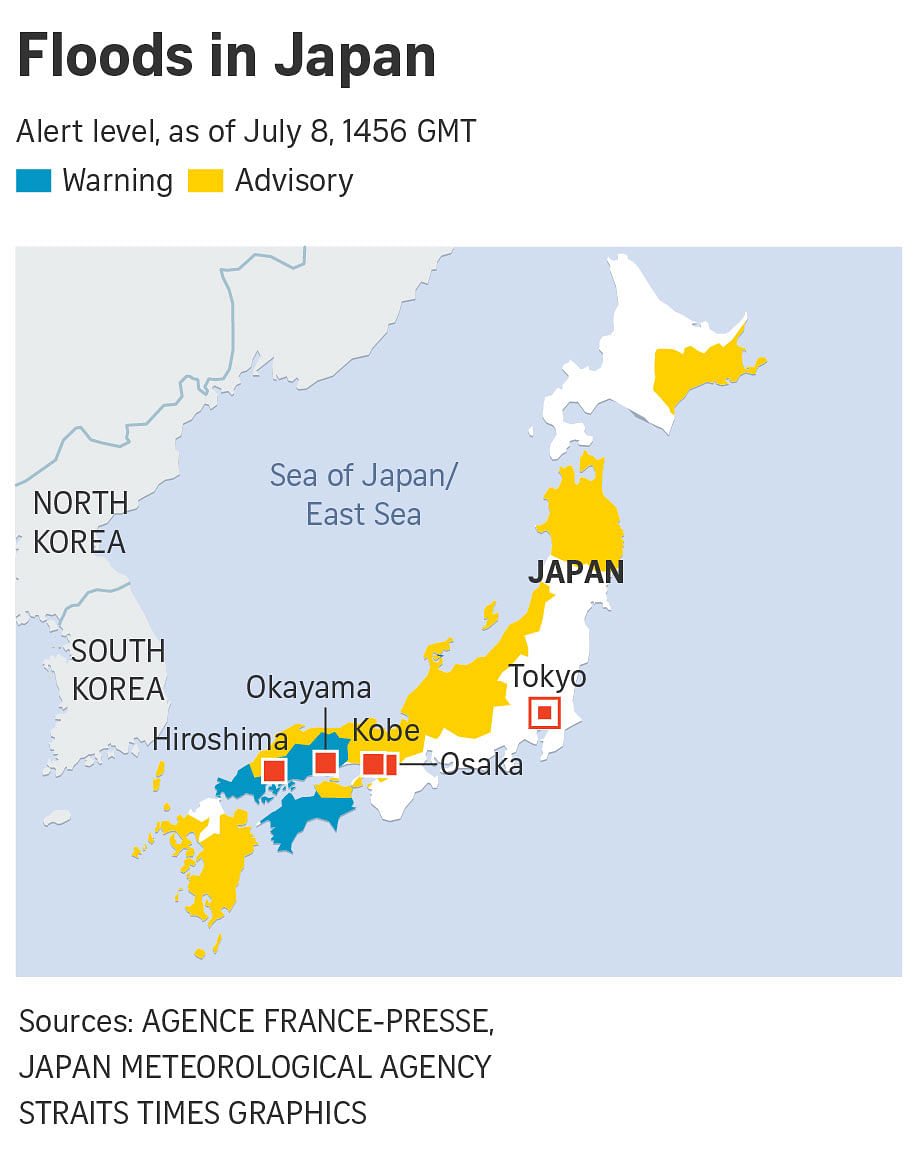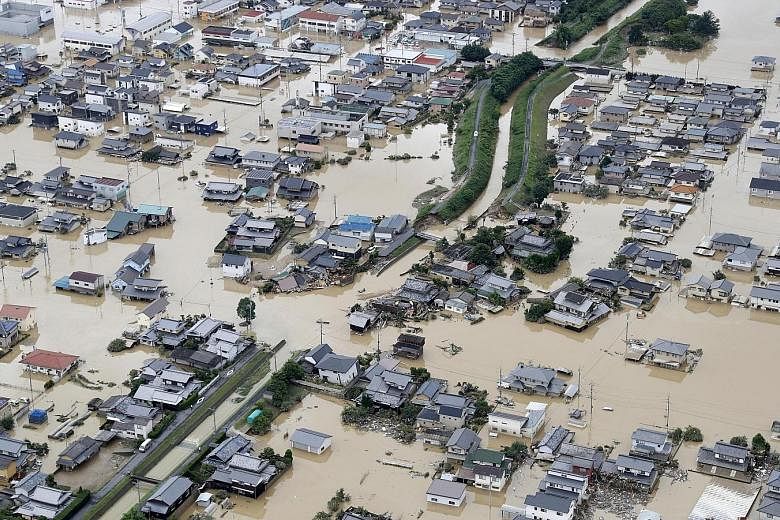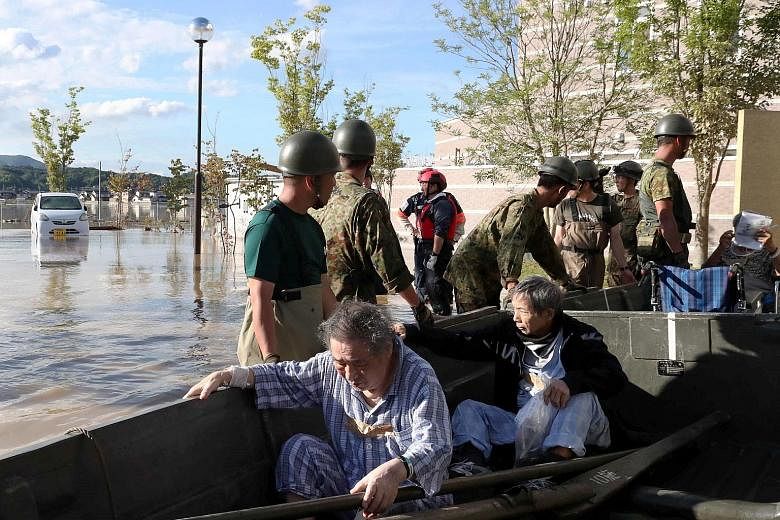KURASHIKI (Japan) • The death toll from torrential rain and landslides in western Japan rose to 81 people yesterday, with dozens still missing after more than 2,000, temporarily stranded in the city of Kurashiki, were rescued.
Evacuation orders were in place for nearly two million people and landslide warnings were issued in many prefectures.
Singapore Prime Minister Lee Hsien Loong yesterday expressed his condolences and offered help to Japan in relief efforts.
"Our thoughts are with you and the people of Japan during this difficult period," PM Lee wrote in a letter to his counterpart, Mr Shinzo Abe. "I am confident that Japan will overcome this disaster with fortitude."
He added: "Please do not hesitate to let us know if Singapore can be of assistance to the ongoing relief efforts."
In hard-hit western Japan, emergency services and military personnel used helicopters and boats to rescue people from swollen rivers and buildings, including a hospital.
Scores of staff and patients, some still in their pyjamas, were rescued from the isolated Mabi Memorial Hospital in boats rowed by members of Japan's Self-Defence Forces.
A city official said 170 patients and staff had been evacuated, while public broadcaster NHK later said about 80 people were still stranded.
Kurashiki, with a population of just under 500,000, was among the hardest hit by rain that pounded many parts of western Japan, with the death toll exceeding the 77 killed in heavy rain and landslides in 2014 and the highest since a typhoon that killed 98 people in 2004.

Television footage showed a massive rescue operation, with 2,310 rescued in the city by evening, according to NHK, while search and rescue teams continued to look for others.
The overall death toll from the rains in Japan rose to at least 81 yesterday after floodwaters forced several million people from their homes, media reports and the Fire and Disaster Management Agency said.
Another 58 were missing, NHK said, and more rain was set to hit some areas for at least another day. The rain set off landslides and flooded rivers, trapping many people in their houses or on rooftops.
"This is a situation of extreme danger," an official at the Japanese Meteorological Agency told a news conference.
A three-year-old girl whose home was hit by a landslide in Hiroshima prefecture was found dead by a search team.
"It's very painful," said one elderly man watching nearby."I have a granddaughter the same age. If it were her, I wouldn't be able to stop crying."
Japan's government set up an emergency management centre at the prime minister's office and some 54,000 rescuers from the military, police and fire departments were dispatched across a wide swathe of western and south-western Japan.
"There are still many people missing and others in need of help, we are working against time," Mr Abe said yesterday morning.
Emergency warnings of severe rain in 11 prefectures - the most since a new warning system was introduced in 2013 - had been lifted by evening, but advisories of heavy rain and landslides remained in effect in many areas.
The rain began late last week as the remnants of a typhoon fed into a seasonal rainy front.
Carmakers including Mazda and Daihatsu suspended operations at several plants last Saturday.
Electronics maker Panasonic said one plant in Okayama, western Japan, could not be reached due to road closures, although it had been closed for the weekend.
REUTERS
I don't know where to start, says farmer on seeing his damaged home
MIHARA (Japan) • Mr Masanori Hiramoto stood before his traditional home in the Japanese town of Mihara, speechless at the destruction caused by record rain that have killed dozens of people.
"I have lived here all my life. I have never seen anything like this," he said, standing in shock before the house where he and his wife raised their three daughters, all now adults.
Mr Hiramoto was one of about 60 evacuees from Hongo district in southern Hiroshima prefecture, who ventured back to their homes yesterday, two days after fleeing when authorities issued evacuation orders.
More than two million people across parts of central and western Japan have been issued similar orders, but they are not mandatory. Many of those who defied the instructions, however, have found themselves caught in flash floods and landslides.
Japan's government said yesterday that at least 81 people had been killed in days of record rain, and the toll was expected to rise further. Dozens more remained missing.
As Mr Hiramoto inspected his ravaged home, it became clear that his decision to evacuate was the right one.
He did not bother to observe the Japanese custom of removing his shoes before entering his home, stepping over a muddle of debris piled outside the front door straight onto flooring caked in mud.
"I'm looking at losses worth 10 million yen (S$123,000)," he said, still dressed in the mud-covered shorts he was wearing when he evacuated last Friday night. "I don't know where to start cleaning. I don't know what is where."
The 68-year-old farmer had never evacuated his home before, but when a special alert came on the television last Friday night as he watched baseball, he and his wife decided to leave.
On the ground floor of their formerly well-decorated home, the powerful flood water had ripped away the outer layer of the walls, exposing the elaborate bamboo mesh inside.
Photo albums and other family possessions were jumbled together with debris on the floor.
Inside the soiled rooms, the fridge had been toppled over and the damage on the walls showed flood waters had risen well above head height.
Mr Hiramoto's heavy farm equipment, including a tractor, harvester and an industrial rice dryer, had been damaged. He also could not bring himself to see whether they would even start.
He surveyed the scene, looking dazed and unsure where to start. "I might start cleaning when the weather clears. But I need water," he said. "There is no running water. Without water, I cannot clear mud from my house."
AGENCE FRANCE-PRESSE


